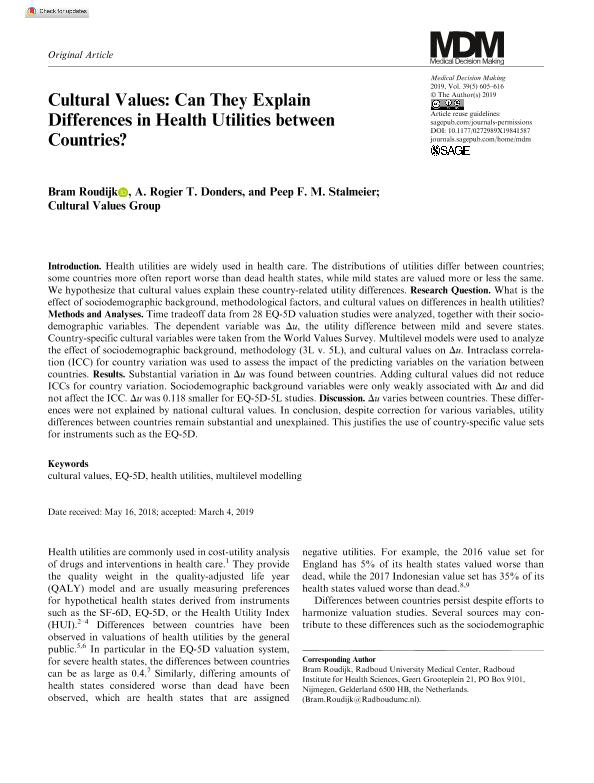Artículo
Cultural Values: Can They Explain Differences in Health Utilities between Countries?
Roudijk, Bram; Donders, A. Rogier T.; Stalmeier, Peep F. M.; Luo, Nan; Viney, Rosalie; Andrade, Monica Viegas; Gudex, Claire; de Pouvourville, Gerard; Greiner, Wolfgang; Scalone, Luciana; Tsuchiya, Aki; Golicki, Dominik; Ferreira, Pedro; Prevolnik-Rupel, Valentina; Badia, Xavier; Hsieh, Ching-Lin; Jelsma, Jennifer; Santos, Marisa; Xie, Feng; Purba, Fredrick; Ikeda, Shunya; Shiroiwa, Takeru; Stolk, Elly; Jo, Min-Woo; Ramos Goñi, Juan Manuel; Augustovski, Federico Ariel ; Rey Ares, Lucila; Devlin, Nancy; Shah, Koonal; Pattanaphesaj, Juntana; Tongsiri, Sirinart
; Rey Ares, Lucila; Devlin, Nancy; Shah, Koonal; Pattanaphesaj, Juntana; Tongsiri, Sirinart
 ; Rey Ares, Lucila; Devlin, Nancy; Shah, Koonal; Pattanaphesaj, Juntana; Tongsiri, Sirinart
; Rey Ares, Lucila; Devlin, Nancy; Shah, Koonal; Pattanaphesaj, Juntana; Tongsiri, Sirinart
Fecha de publicación:
07/2019
Editorial:
SAGE Publications
Revista:
Medical Decision Making
ISSN:
0272-989X
Idioma:
Inglés
Tipo de recurso:
Artículo publicado
Clasificación temática:
Resumen
Introduction. Health utilities are widely used in health care. The distributions of utilities differ between countries; some countries more often report worse than dead health states, while mild states are valued more or less the same. We hypothesize that cultural values explain these country-related utility differences. Research Question. What is the effect of sociodemographic background, methodological factors, and cultural values on differences in health utilities? Methods and Analyses. Time tradeoff data from 28 EQ-5D valuation studies were analyzed, together with their sociodemographic variables. The dependent variable was (Formula presented.), the utility difference between mild and severe states. Country-specific cultural variables were taken from the World Values Survey. Multilevel models were used to analyze the effect of sociodemographic background, methodology (3L v. 5L), and cultural values on (Formula presented.). Intraclass correlation (ICC) for country variation was used to assess the impact of the predicting variables on the variation between countries. Results. Substantial variation in (Formula presented.) was found between countries. Adding cultural values did not reduce ICCs for country variation. Sociodemographic background variables were only weakly associated with (Formula presented.) and did not affect the ICC. (Formula presented.) was 0.118 smaller for EQ-5D-5L studies. Discussion. (Formula presented.) varies between countries. These differences were not explained by national cultural values. In conclusion, despite correction for various variables, utility differences between countries remain substantial and unexplained. This justifies the use of country-specific value sets for instruments such as the EQ-5D.
Palabras clave:
CULTURAL VALUES
,
EQ-5D
,
HEALTH UTILITIES
,
MULTILEVEL MODELLING
Archivos asociados
Licencia
Identificadores
Colecciones
Articulos(CIESP)
Articulos de CENTRO DE INVESTIGACIONES EN EPIDEMIOLOGIA Y SALUD PUBLICA
Articulos de CENTRO DE INVESTIGACIONES EN EPIDEMIOLOGIA Y SALUD PUBLICA
Citación
Roudijk, Bram; Donders, A. Rogier T.; Stalmeier, Peep F. M.; Luo, Nan; Viney, Rosalie; et al.; Cultural Values: Can They Explain Differences in Health Utilities between Countries?; SAGE Publications; Medical Decision Making; 39; 5; 7-2019; 605-616
Compartir
Altmétricas



